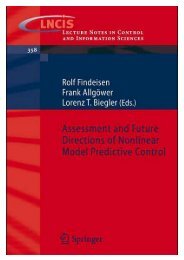The Stability of Linear Feedback Systems
The Stability of Linear Feedback Systems
The Stability of Linear Feedback Systems
You also want an ePaper? Increase the reach of your titles
YUMPU automatically turns print PDFs into web optimized ePapers that Google loves.
5.4 <strong>The</strong> Determination <strong>of</strong> Root Locations in the s-Plane<br />
221<br />
root <strong>of</strong> 5 = - I. In this table, we multiply by the trial root and succesadd<br />
in each column. With a remainder <strong>of</strong>one, we might try s = - 2, which<br />
in the form<br />
4 6 4 1-2<br />
-2 -4 -4<br />
2 2 0<br />
the remainder is zero, one root is equal to - 2 and the remaining roots<br />
obtained from the remaining polynomial (52 + 25 + 2) by using the qualOOt<br />
formula.<br />
search for a root <strong>of</strong>the polynomial can be aided considerably by utilizing<br />
<strong>of</strong> change <strong>of</strong> the polynomial at the estimated root in order to obtain a<br />
tllimate. <strong>The</strong> Newton-Raphson method is a rapid method utilizing synthetic<br />
to obtain the value <strong>of</strong><br />
d~;) L"<br />
II is a first estimate <strong>of</strong> the root. <strong>The</strong> Newton-Raphson method is an iterach<br />
utilized in many digital computer root-solving programs. A new<br />
SUI <strong>of</strong>the root is based on the last estimate as [I8, 19]<br />
q(s.)<br />
SHl = s~ - q'(S~)'<br />
(5.21 )<br />










![[Language - English] - Life Skills - Writing](https://img.yumpu.com/44143758/1/190x245/language-english-life-skills-writing.jpg?quality=85)





